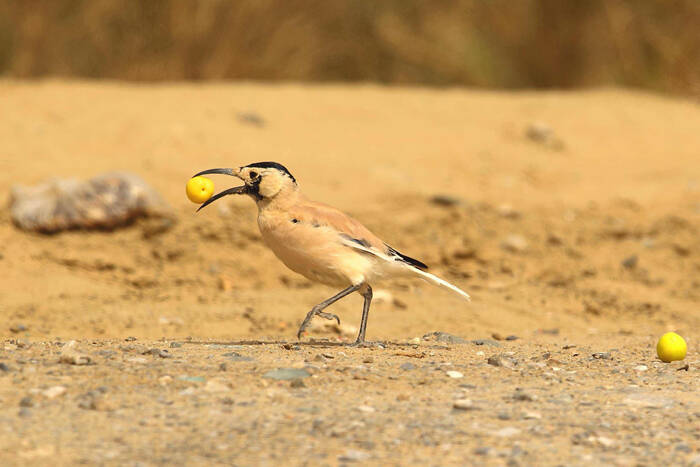Podoces biddulphi
IUCN
LCBasic Information
Scientific classification
- name:Podoces biddulphi
- Scientific Name:Podoces biddulphi,Xinjiang Ground-jay,Xinjiang ground crow, Biddulph ground crow, sand magpie, desert bird
- Outline:Songbird
- Family:Passeriformes Corvidae Corvus
Vital signs
- length:26-31cm
- Weight:102-141g
- lifetime:No verification information
Feature
Tail feathers white, but the two central tail feathers have black shafts
Distribution and Habitat
White-tailed ground jay is a bird species endemic to China, distributed only in the desert provinces in the west, and can be seen in the Taklimakan Desert and the Tarim Basin in the southern Xinjiang region of Xinjiang.
It mainly inhabits dry plains and desert areas at the foot of mountains, especially in sandy desert areas with sparse vegetation. It is distributed only in a ring-shaped area with an altitude of 900-1300 meters where poplars grow in the foothills of the Taklimakan Desert in Xinjiang, China, east to Lop Nur.
Appearance
The plumage of male and female white-tailed ground jays is similar. The plumage of the whole body is mainly creamy brown, and the top of the head to the nape is black with a purple-blue metallic luster. The nape feathers are extended to form a broad and short crest draped over the nape, which is very eye-catching on the light-colored head. The front of the eyes, around the eyes, the sides of the head and the sides of the neck are creamy yellow, and the large wing coverts are black with a purple-blue metallic luster, and the outermost feather edges are white. The middle of the primary flight feathers is white, the base and the tip are black, and the black tip becomes smaller as it goes inward, and the white range becomes larger. The innermost primary flight feathers are all white, forming a large white terminal spot on the wing. The secondary flight feathers and tertiary flight feathers are black with a purple luster and white tips. The innermost tertiary flight feathers are not only wh
Details
White-tailed Ground-jay is called Xinjiang Ground-jay in foreign language, and has no subspecies.

White-tailed Ground-jay is a resident bird. It mainly runs, moves and forages in the desert on the ground. It often moves alone or in pairs, is good at running, moves quickly, and rarely flies except in critical situations. Even if it flies, the distance is very short. Sometimes it also perches on bushes and dead branches and calls. It can make a "di, di, di" call. Call: repeated three-syllable chui-chui-chui sound, the last note rises, and there is a series of low whistles that are fast and depressed.
The main food of white-tailed crows is insects that can be found in the desert, among which various ground beetles of the order Coleoptera are the main ones, in addition to Orthoptera and Diptera insects, small lizards and a small number of plant seeds and fruits.
The breeding season of white-tailed crows is from March to June. They build nests between the branches of dead trees, and the nests are built with materials such as dead grass, dead leaves, and animal hair. The nest is cup-shaped, with an outer diameter of 35 cm and an inner diameter of 15.2 cm. 1-3 eggs are laid per nest.
The White-tailed Ground Raven lives in the Taklimakan Desert in Xinjiang, western China, with some records in the eastern part of the region, such as the Qaidam Basin in Qinghai Province and Dunhuang in Gansu Province. It was common in 1929-1930, but rare and difficult to find in the same area in 1988. However, it was found to be widespread and locally common in the interior of the Taklimakan Desert after 2011. Populations are thought to be declining due to habitat conversion and degradation. It has been suggested that the species is expanding its range eastward from its original habitat due to desertification and climate change, and a recent study found evidence that the species has also been present in Gansu since at least the 19th century (Stein 1921 in: Londei 2013).
Listed in the IUCN Red List of Threatened Species in 2017 ver 3.1 - Near Threatened (NT).
Listed in China's National Key Protected Wildlife List (February 5, 2021) Level 2.
Listed in the National List of Terrestrial Wildlife with Important Economic and Scientific Research Value (Item 425) issued by the State Forestry Administration of China on August 1, 2000.
Protect wild animals and stop eating game.
Maintaining ecological balance is everyone's responsibility!








